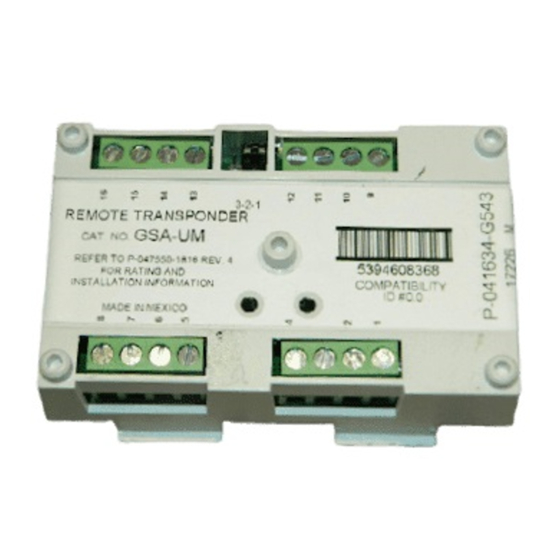
Advertisement
GSA-UM Universal Class A/B Module Installation
Sheet
The GSA-UM Universal Class A/B Module is an addressable
module that you can configure to provide one of the following:
•
Two Class B dry contact initiating device circuits
•
One Class A dry contact initiating device circuit
•
One Class A or Class B notification appliance circuit
•
One Class A or Class B verified two-wire (conventional)
smoke detector circuit without dry contact initiating devices
on the same circuit
•
One Class A or Class B unverified two-wire (conventional)
smoke detector circuit with or without dry contact initiating
devices on the same circuit
•
One Form C dry contact relay output
The GSA-UM requires two device addresses on the signaling
line circuit (SLC). Addresses are assigned electronically. There
are no addressing switches.
Diagnostic LEDs provide visible indication of the status of the
module:
•
Normal: Green LED flashes
•
Alarm/active: Red LED flashes
Personality codes
The module requires the loop controller to download the
personality code that determines how the module operates.
Use the personality codes described below to configure the
GSA-UM. Refer to Table 1 for UL 864 programming
requirements. See
Table 2 for personality code electrical characteristics.
© 2017 United Technologies Corporation
Table 1: UL 864 programming requirements
This product incorporates field-programmable software. In order for the
product to comply with the requirements in the Standard for Control
Units and Accessories for Fire Alarm Systems, UL 864, certain
programming features or options must be limited to specific values or
not used at all as indicated below
Program feature or
Permitted in
option
UL 864?
Personality code 2
No
Personality code 10
No
Personality code 1:
Alarm - NO latching (Class B): Factory
default. Configures input 1 or 2 for Class B, normally open dry
contact initiating devices (e.g., pull stations, heat detectors,
etc.). When the NO input contact of an initiating device is
closed, an alarm signal is sent to the loop controller and the
alarm condition is latched at the module.
Personality code
2: Alarm - NO delayed latching (Class B):
Same as code 1 except that contact closure must be
maintained for approximately 16 seconds before an alarm
signal is sent. This code is only for use with nonretarded
waterflow alarm switches.
Personality code
3: Active - NO nonlatching (Class B):
Contact closure causes an active instead of an alarm status
and does not latch at the module. Code 3 is typically used for
monitoring fans, dampers, and doors.
Personality code 4:
Active - NO latching (Class B): Contact
closure causes an active instead of an alarm status, which is
latched at the module. Code 4 is typically used for monitoring
supervisory and tamper switches.
Personality code 8:
Signal - dry contact output: Configures
the module as a Form C dry relay contact to control external
appliances (door closers, fans, dampers) or equipment
shutdown. Note: Jumper JP1 must be moved to pins 2 and 3
for dry contact operation.
Personality code 9:
Alarm - NO latching (Class A): Configures
the module for connection of Class A, normally open dry
contact initiating devices (e.g., pull stations, heat detectors,
etc.). When the NO input contact of an initiating device is
closed, an alarm signal is sent to the loop controller and the
alarm condition is latched at the module.
P/N P-047550-1816-EN • REV 007 • ISS 21SEP17
1 / 7
Possible
Settings
settings
permitted in
UL 864?
N/A
N/A
N/A
N/A
Advertisement
Table of Contents

Summary of Contents for Kidde GSA-UM
- Page 1 Personality code 1: Alarm - NO latching (Class B): Factory The GSA-UM Universal Class A/B Module is an addressable default. Configures input 1 or 2 for Class B, normally open dry module that you can configure to provide one of the following: contact initiating devices (e.g., pull stations, heat detectors,...
-
Page 2: Installation
Personality Code 10: Alarm - NO delayed latching (Class A): Installation Same as code 9 except that contact closure must be maintained for approximately 16 seconds before an alarm WARNINGS signal is sent. Code 10 is typically used with waterflow alarm •... - Page 3 Locate all bells and horns at least 6 ft. (1.8 m) from the module. • A maximum of 15 GSA-UM modules per circuit can be configured to support two-wire smoke detectors To install a transient protector: (personality codes 13, 14, 20, and 21). However, if a Signature Series IM module or Signature Series detector Install the transient protector inside the module’s electrical...
- Page 4 3 2 1 + (5) Figure 4: Form C dry contact relay (personality code 8) (1) GSA-UM must be installed in the same room as the device it (1)(2)(3) controls (2) Power-limited unless connected to a nonpower-limited source. If the source is nonpower-limited, eliminate the power-limited mark and maintain a minimum of 0.25 in.
- Page 5 Figure 5: Class A initiating device circuit (personality codes 9, 10, 11, 12) (1) Input 1: Typical NO initiating device (2) Maximum 10 VDC at 350 µA (3) Maximum 12.5 Ω resistance per wire for Class A configurations. (4) Supervised and power-limited unless connected to a nonpower- limited source.
-
Page 6: Specifications
Figure 7: Class A or B notification appliance circuit (personality codes 15, 16) (1) Class A notification appliance circuit (2) Class B notification appliance circuit (3) Signal polarity shown when the circuit is normal. Polarity (2)(3)(4)(5) reverses when the circuit is active. (4) Use twisted pair wires for speaker circuits. -
Page 7: Regulatory Information
Regulatory information North American UL864, CAN/ULC-S527 standards FCC compliance This device complies with part 15 of the FCC Rules. Operation is subject to the following two conditions: (1) This device may not cause harmful interference, and (2) this device must accept any interference received, including interference that may cause undesired operation.











Need help?
Do you have a question about the GSA-UM and is the answer not in the manual?
Questions and answers